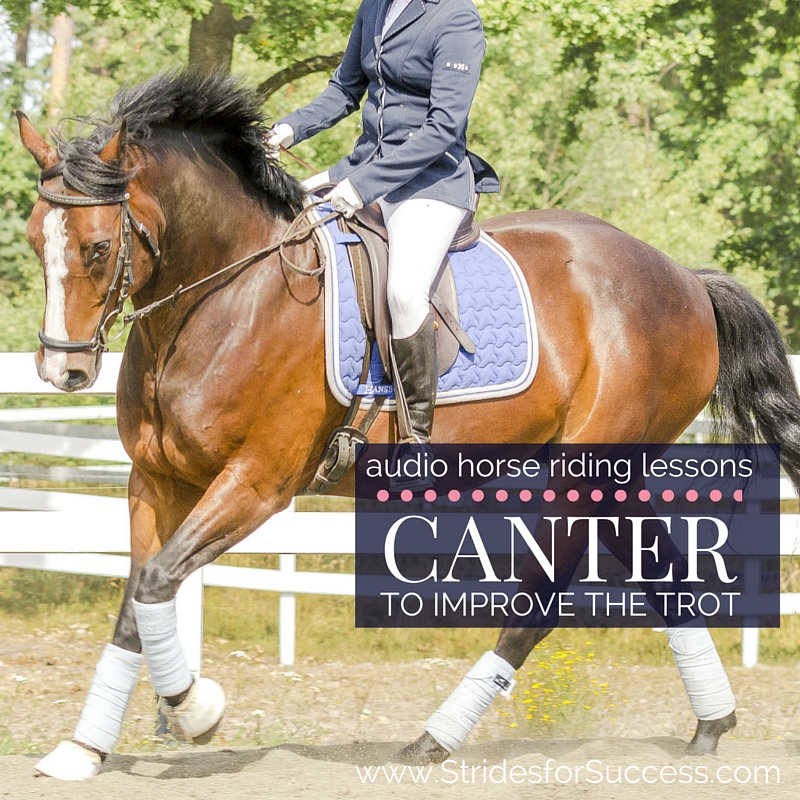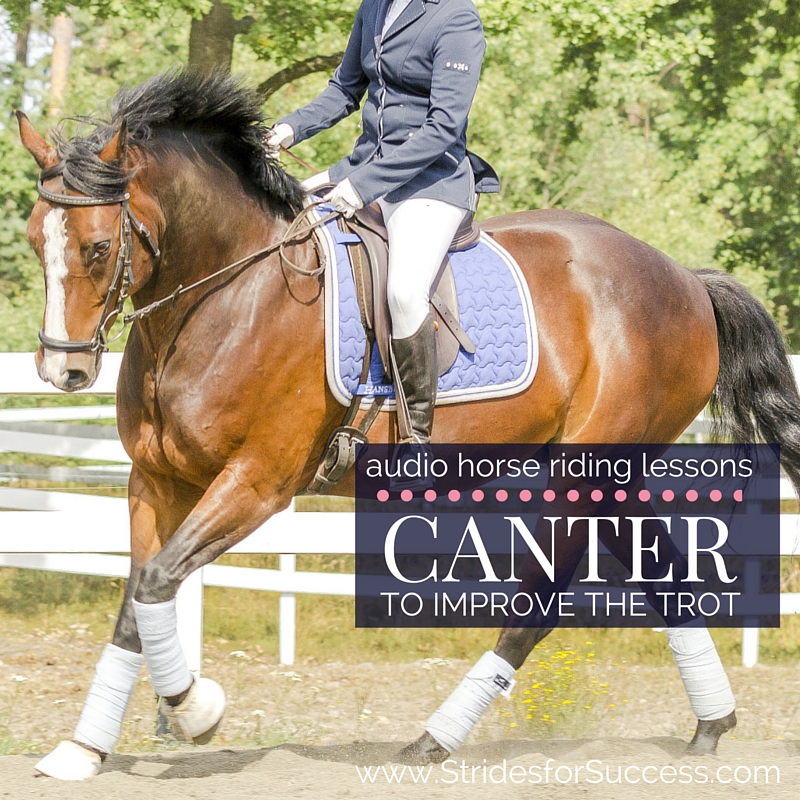🌟🐴 Get the Improve Your Canter Program TODAY and transform your riding – and your training 🐴🌟
Have you noticed how, very often, there are only two ‘gears’ when trotting; a good, forward trot or a bland, shuffle trot? However, changing from the latter to the former can often be one of the more difficult aspects of trotting. If so, have you ever considered using the canter to improve the trot?
Sounds too good to be true, but very often a good, forward canter can be the simple catalyst from that mediocre flat shuffle, to that wonderful springy and engaged trot.
However, like everything worth doing in life, the canter must be of good quality, and the transitions both into and out of the canter from the trot will often dictate just how effective this technique will be to your horse’s schooling.
What Makes a Good Trot?
So, before we go any further, let’s chat quickly about what exactly makes a good trot. The trot itself is usually quite easy to establish a rhythm, the 1.. 2.. 1.. 2.. almost setting itself up each stride. The trouble for many riders is then regulating the tempo of that rhythm.
If the rhythm is the 1.. 2.. 1.. 2.. the tempo is how often that 1.. 2.. rhythm occurs in any set period of time or distance.
For example, take the long side of a 60m arena. By adjusting the tempo of the trot rhythm, you can either have a lot of ‘quick’ 12121212s occurring, or you can have fewer 1…… 2…… 1…… 2……. happening in the same distance.
So when many riders begin trotting, establishing the rhythm and tempo is often not a problem. But as soon as they begin to make adjustments to the trot, one (usually the tempo) or both can very quickly become erratic. Those adjustments can be half halts, shortening the stride, lengthening the stride, or asking for a transition either up or down to a different gait, or within the gait itself.
In fact, even just beginning to activate the hind quarters and connect the horse a little more very often results in a loss of rhythm and tempo. This is where we see many horses either begin to run in the trot, or become heavy and lean on the rider’s hand.
Canter to Improve the Trot
Riding the canter to improve the trot will help riders to firstly become more quiet in the saddle. It also improves the riders skills in noticing if the gait itself is a quality one to begin with
Because of the transitions between trot and canter, riders may want to rather ride in a sitting trot when riding the trot. However, I strongly suggest just using the sitting trot for the actual transition. Post or rise to the trot when working in the trot. The reason I say this is because, in order to improve the quality of the trot, the horse must first engage his hindquarters.
For this to happen, the energy being created there must be allowed to connect through, underneath the rider and saddle, from the back to the front
Using Your Energy Wisely
However, it has been my experience that when working between trot and canter for any length of time, riders tire quickly. This causes them to begin ’slouching’ through their upper body and this, in turn, results in them ‘shutting down’ that flow of energy necessary for the horse to truly work in a quality trot.
So, for the duration of this exercise, I suggest working in rising or posting to the trot where you can, to give both yourself and your horses back a little break!
Start with ‘Forward’
Start by asking your horse to work in what you would consider a forward-going ‘working trot’. Focus on the rhythm and then the tempo, particularly as you work through corners or change rein. Can your horse remain to maintain consistency in both? Many riders wonder if the trot is indeed a ‘working trot’.
The next part of the exercise will quickly tell you either way if your trot is working, or shuffling!

Using Half Halts to Prepare
Begin to prepare your horse for canter. Use your half halts, but all the while paying close attention to the aforementioned rhythm and tempo. I also think noticing how straight your horse remains through the transition is important. Do his hindquarters swing or drift? Does he ‘curl’ around your inside leg? Or perhaps he is bracing against your inside leg…? If you notice any of the above, take this as your cue to begin working through these more basic evasions, before you allow your horse to canter.
You may find maintaining the rhythm and, in particular, tempo as your horse transitions into canter from the trot rather difficult. This is what your focus should be on throughout the schooling session.
Think of ‘you ask – he responds’
Working Forward in the Canter
Once in the canter, firstly make sure the canter is moving forward and actually taking you somewhere. One of the reasons we can use the canter to improve the trot is because the canter often has naturally more energetic and rolling energy with it. Having to push and kick at every stride is not forward. But it is important to note that allowing your horse to run like a wild thing around the arena is also not a forward canter.
The canter can be classed as ‘forward’ if the energy is taking you somewhere and that somewhere is dictated by you. You can influence where it goes and how much is allowed ‘out’ at any give time in the gait
The Canter to Trot Transition
Once you have indeed established a forward canter, you can begin thinking about transitioning back into the trot. Again, maintaining the rhythm and tempo is vitally important. What is also important is the fact that you ‘allow’ your horse to trot.
There is a split second, that you will feel, when your horse actually takes that step that transitions him from the canter into the trot. In order to do this he must ‘land’ into the trot. And you must ‘allow’ or ‘soften’ through your hand so he can indeed move forward into the trot
This is also where I suggest posting or rising from the first step. This way, when you have ‘allowed’ him to continue to move forward, that energy in his hind quarters can indeed connect with the front end. It will feel like he is ‘swinging’ underneath you.
Feeling the Difference to the Trot
Many riders find that the first time they really ride a good trot with their horse, the bounce is a little too much for them. Again, rising or posting will help you initially. Then, later, as you become more supple and allowing through your body, you can start moving with your horse and this new energy in sitting trot.
You can use the canter to improve the trot both in the saddle and on the ground. The same principles can be applied when lunging your horse with the added bonus of actually being able to see the results, rather than feel them
Keep in mind that in order for your horse to improve and develop himself, it is your responsibility to establish and maintain that straightness, rhythm, and tempo. Work towards being able to move up and down, through your horse’s gears, without losing any of the above.
It is also vital that your horse continues to ‘move forward’ at all times; taking you somewhere.
Happy Riding
Lorna
Improve Your Canter Program
4 weeks of self-study with easy-to-follow audio horse riding lessons that will help you to transform your canter – and your aids in your riding. Suitable for riders who are just getting started with canter, and riders who want to improve both their abilities and their horse’s canter.
And with lifetime access, you can dip in and out of the program again, and again… All of the details are HERE
Connection; The Online Resource for Riders
This podcast is the first in a series of five on this specific topic which were created for Daily Strides Premium, now know as Connection. Every month you will get audio horse riding lessons to listen to as you work your horse. Connection is created to help riders working alone, without a trainer or coach, to continue to both improve their riding AND train their horse.
All of the audio programs are step-by-step instructions for you to follow while riding your horse. All of your lessons are available, on your phone, using a Private Podcast Feed.
All of the details are available at https://stridesforsuccess.com/join. The membership is risk free, with no contracts. You can cancel any time. I would love to have you on a lesson soon :)

